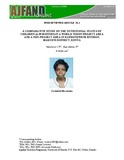A Comparative Study On The Nutritional Status Of Children (6-59 Months) In A World Vision Project Area And A Non-project Area In Kathonzweni Division, Makueni District, Keny

Date
2005Author
Macharia, CW
Kogi-Makau, W
Muroki, MN
Type
ArticleLanguage
enMetadata
Show full item recordAbstract
A cross-sectional survey was conducted in Kathonzweni division, Makueni district to
assess and compare the nutritional status of children (6-59 months) drawn from
households participating in a World Vision project vis-à-vis non-project area. The
purpose of the study was to provide region specific data on the nutrition situation in the
World Vision Project area and establish whether there is any significant difference from
the non-operational area. A total of 320 households, of which 160 were from the World
Vision project area each with at least a child aged between 6-59 months were randomly
selected. In households with more than one child at this age category, only one child was selected. Structured questionnaires were administered to mothers or to alternative
caretakers while anthropometric measurements were taken for all the children in the
study households. Statistical package for Social Scientists (SPSS/PC+) computer
package was used for data entry and analysis. Indices of nutritional status that is
weight-for-age, height-for-age and weight-for-height were computed using the Epi-Info
programme. The prevalence of stunting in the project area (46.5%) was slightly higher
than among the non-project area (42.1%). A significant relationship was found between
the children's age and their nutritional status based on the prevalence of wasting and of
underweight (p<0.01) while nutritional status, based on stunting, was significantly
associated with birth order. Overall, there was no significant difference in prevalence of
stunting, wasting and underweight between the world vision project area and nonproject area. However, the prevalence of stunting and underweight was higher than the national levels. It is, therefore, concluded that chronic malnutrition is a problem in the study area and age is an important determining factor. Even though World Vision
Kenya has been involved in development projects in the area, there is still need for more targeted nutrition interventions by the organization.
URI
http://www.ajfand.net/Volume5/No1/Macharia1240.pdfhttp://erepository.uonbi.ac.ke:8080/xmlui/handle/123456789/54332
Citation
African Journal of Food Agriculture and Nutritional Development (AJFAND): Volume 5 No 1 2005Publisher
University of Nairobi Department of Food Science, Nutrition & Technology
